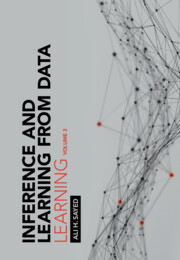Refine listing
Actions for selected content:
9096 results in Communications, Signal Processing and Information Theory

An Introduction to Optimization on Smooth Manifolds
-
- Published online:
- 09 March 2023
- Print publication:
- 16 March 2023

Inference and Learning from Data
- Learning
-
- Published online:
- 24 February 2023
- Print publication:
- 22 December 2022
-
- Textbook
- Export citation

Inference and Learning from Data
- Foundations
-
- Published online:
- 17 February 2023
- Print publication:
- 22 December 2022
-
- Textbook
- Export citation
Index
-
- Book:
- Age of Information
- Published online:
- 02 February 2023
- Print publication:
- 09 February 2023, pp 478-482
-
- Chapter
- Export citation
18 - UAV-Assisted Status Updates
-
-
- Book:
- Age of Information
- Published online:
- 02 February 2023
- Print publication:
- 09 February 2023, pp 456-477
-
- Chapter
- Export citation
4 - Controlling the Age of Information: Buffer Size, Deadlines, and Packet Management
-
-
- Book:
- Age of Information
- Published online:
- 02 February 2023
- Print publication:
- 09 February 2023, pp 89-114
-
- Chapter
- Export citation
Acknowledgments
-
- Book:
- Age of Information
- Published online:
- 02 February 2023
- Print publication:
- 09 February 2023, pp xii-xii
-
- Chapter
- Export citation
2 - On the Distribution of AoI
-
-
- Book:
- Age of Information
- Published online:
- 02 February 2023
- Print publication:
- 09 February 2023, pp 36-58
-
- Chapter
- Export citation
17 - Economics of Fresh Data Trading
-
-
- Book:
- Age of Information
- Published online:
- 02 February 2023
- Print publication:
- 09 February 2023, pp 429-455
-
- Chapter
- Export citation
16 - Transmission Preemption for Information Freshness Optimization
-
-
- Book:
- Age of Information
- Published online:
- 02 February 2023
- Print publication:
- 09 February 2023, pp 406-428
-
- Chapter
- Export citation
14 - Information Freshness in Large-Scale Wireless Networks: A Stochastic Geometry Approach
-
-
- Book:
- Age of Information
- Published online:
- 02 February 2023
- Print publication:
- 09 February 2023, pp 364-383
-
- Chapter
- Export citation
5 - Timely Status Updating via Packet Management in Multisource Systems
-
-
- Book:
- Age of Information
- Published online:
- 02 February 2023
- Print publication:
- 09 February 2023, pp 115-139
-
- Chapter
- Export citation
1 - The Probability Distribution of the Age of Information
-
-
- Book:
- Age of Information
- Published online:
- 02 February 2023
- Print publication:
- 09 February 2023, pp 1-35
-
- Chapter
- Export citation
13 - Reinforcement Learning for Minimizing Age of Information over Wireless Links
-
-
- Book:
- Age of Information
- Published online:
- 02 February 2023
- Print publication:
- 09 February 2023, pp 327-363
-
- Chapter
- Export citation
11 - Relation between Value and Age of Information in Feedback Control
-
-
- Book:
- Age of Information
- Published online:
- 02 February 2023
- Print publication:
- 09 February 2023, pp 286-296
-
- Chapter
- Export citation
3 - Multisource Queueing Models
-
-
- Book:
- Age of Information
- Published online:
- 02 February 2023
- Print publication:
- 09 February 2023, pp 59-85
-
- Chapter
- Export citation
Contributors
-
- Book:
- Age of Information
- Published online:
- 02 February 2023
- Print publication:
- 09 February 2023, pp vii-xi
-
- Chapter
- Export citation
15 - The Age of Channel State Information
-
-
- Book:
- Age of Information
- Published online:
- 02 February 2023
- Print publication:
- 09 February 2023, pp 384-405
-
- Chapter
- Export citation
8 - Age-Efficient Scheduling in Communication Networks
-
-
- Book:
- Age of Information
- Published online:
- 02 February 2023
- Print publication:
- 09 February 2023, pp 199-229
-
- Chapter
- Export citation
Frontmatter
-
- Book:
- Age of Information
- Published online:
- 02 February 2023
- Print publication:
- 09 February 2023, pp i-iv
-
- Chapter
- Export citation
